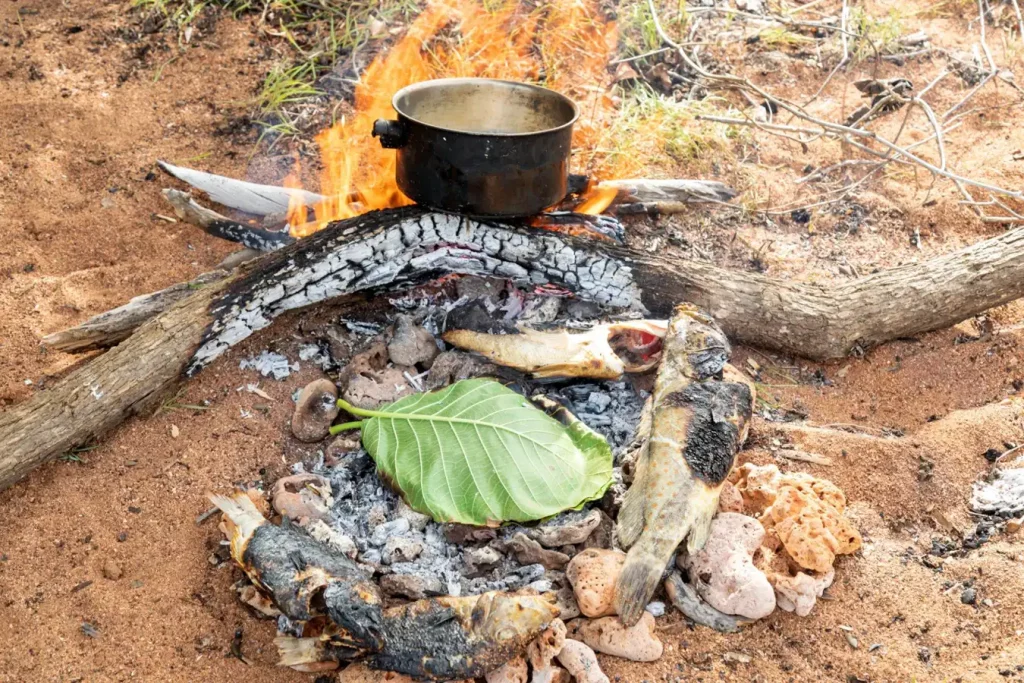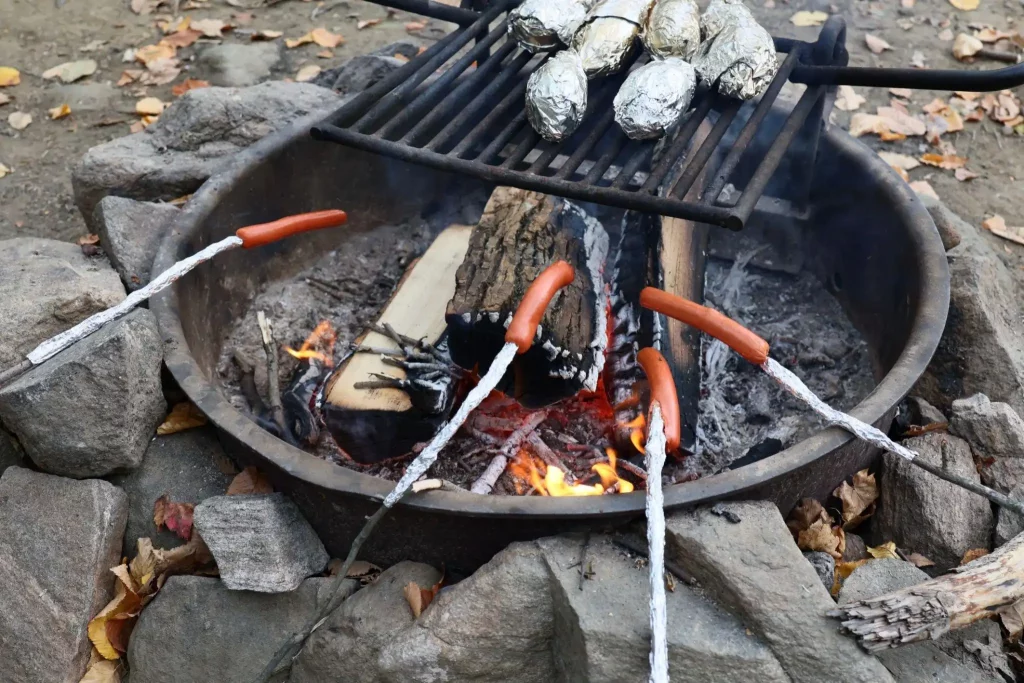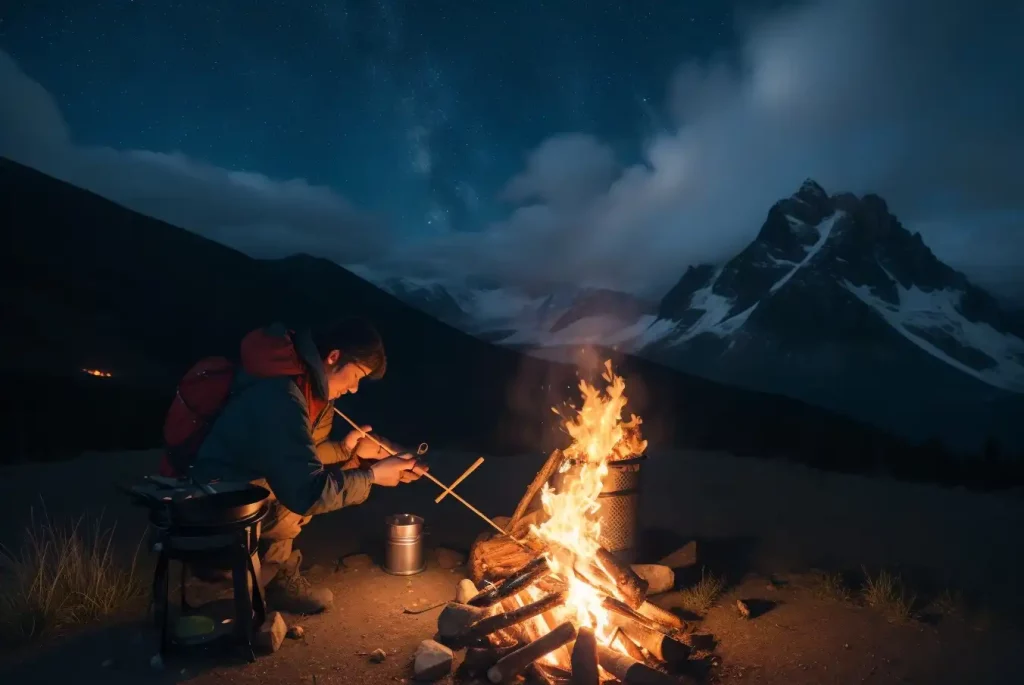Hey there, fellow outdoor enthusiasts! 🔥 Campfire grilling techniques aren’t just about throwing a chunk of meat on a fire and hoping for the best.
Nope, there’s an art to it, my friends!
So, why should you read on?
Well, we’re diving deep into the world of campfire grilling, where the steak tastes better, and the experiences last a lifetime.
If you’re up for the challenge, keep reading!
Why Grilling Over a Campfire is Unique
The Romanticized Idea vs. The Reality
Ah, the movies make it look so easy, don’t they? Just spear a fish with a hand-carved stick and roast it over an open flame. In about two minutes, you’re feasting like a king. Well, reality check: it’s not that simple.
But don’t get me wrong! There’s something absolutely magical about cooking on an open flame, surrounded by nature. The smoky flavor you get? Unbeatable.
Challenges and Benefits
First, let’s talk about the challenges. You’re not in a controlled environment, so factors like wind speed, wood type, and even altitude can affect your grilling game.
On the flip side, the benefits are off the charts. Think about it: the delicious, smoky flavor, the camaraderie around the fire, and not to mention the primal satisfaction of cooking food the way our ancestors did. Yeah, it’s totally worth it.
Don’t forget, a quality campfire cooking kit can make all the difference in easily tackling the challenges and reaping the benefits of this unique grilling experience.

Setting Up Your Campfire for Grilling
Choosing the Right Wood
Wood matters, period. Hardwoods like oak, hickory, or mesquite offer a long-lasting heat and add a subtle, smoky flavor to your food. Softwoods like pine? A big no-no. They burn too fast and can give your food a resinous taste. Yuck!
Positioning of Logs
The log-cabin setup is my go-to. Why? Because it provides even heat and it’s less likely to collapse into an unmanageable blaze. Just lay two larger logs parallel to each other, and then stack two more on top perpendicularly. Keep building upwards, and voila, you’ve got a cooking-friendly fire!
How to Achieve the Ideal Heat
What you’re aiming for here is a bed of glowing embers. You want to let the logs burn down until they’re white-hot. At this point, spread out the embers evenly.
But hey, leave a ‘cool zone’ with fewer embers, just in case you need a spot to move food that’s cooking too quickly.
Learn more: Direct vs Indirect Cooking Methods

The Key Temperatures for Campfire Grilling
How to Gauge the Fire’s Heat Without a Thermometer
No thermometer? No problem! Use the hand test. Hold your hand about 6 inches above the fire. If you can only keep it there for 2 seconds, you’re at high heat. 4 seconds? Medium heat. 6 seconds or more? You’re in the low-heat zone.
Different Zones for Different Food Items
When grilling, not all food is created equal. For example, veggies and shellfish do well on high heat, but for larger cuts of meat, medium to low heat is your friend.
Feel free to add or adjust according to your experience. Alright, what are we waiting for? Let’s get grilling!
To know more: Coals or Wood: What’s the Best Fuel?
Tools of the Trade
Grilling Grates
Alright, so you’ve got the fire roaring. Now, what are you gonna cook on? Trust me, a grilling grate is your best pal out here. It gives you a stable surface, making it easier to manage your meat and veggies.
No need to worry about that beautifully marinated chicken breast falling into the abyss of the fire. And the grill marks? Oh man, they’re like the tattoos of the grilling world—pure art!
Skewers
Now, if you’re into something a bit more rustic, skewers are the way to go. They’re perfect for smaller items like shrimp, veggies, or even chunks of meat. Just slide ’em on and hold them over the fire.
Bamboo or metal, both work fine, but if you’re going all-natural, a sturdy, green tree branch will do the trick. Just make sure to strip off the bark to avoid any weird flavors.
Cast Iron Cookware
Cast iron pans and Dutch ovens? These bad boys are a godsend when camping. You can cook anything from stir-fries to stews, and they hold heat amazingly well. Plus, they’re durable as all get-out. Just remember they’re heavy, so maybe not the best for a long hike unless you’re looking to build some serious muscle.
Tongs and Gloves
Last but definitely not least, let’s talk about tongs and gloves. Friends, don’t be a hero. Grabbing hot food or adjusting logs with your bare hands isn’t cool; it’s how you get burns. A decent pair of long tongs will give you the reach and control you need. And as for gloves, get a pair that can handle high heat; your hands will thank you.
How to Keep Tools Clean and Safe
Importance of Hygiene, Especially in an Outdoor Setting
We’re in nature, but that doesn’t mean we go full caveman, alright? Keeping your tools clean is vital. Remember, you’re in an environment exposed to dirt, insects, and who knows what else. A bit of hygiene can mean the difference between a great meal and a night spent getting to know the bushes around your campsite on a very personal level, if you catch my drift.
Cleaning Hacks Using Natural Materials like Sand or Lemon
Ran out of soap? Nature’s got you. Good ol’ sand works as a natural abrasive. Just scrub it against your cooking surface, and you’ll get off most of the grime. Got a lemon? Even better. Cut it in half and scrub it over your tools. It not only cleans but also leaves a pleasant scent.
Alright, folks, now you’ve got the lowdown on the essential tools and how to keep them spick and span. Stick around for the next part where we’re gonna talk about the actual cooking techniques that will make you a campfire gourmet!
Campfire Grilling Techniques
So, you’ve got your fire all set up, and your tools are ready to go. Now, what? Time to dive into some killer campfire grilling techniques that’ll turn you into the culinary hero of your next outdoor adventure. Let’s get into it.
Direct Heat Method
When to Use It
First up, we’ve got the Direct Heat Method. This is your go-to for fast cooking. Think of it as the sprinter of the grilling world—quick and to the point.
Suitable Food Items
You’re looking at stuff like burgers, hot dogs, and thinner steaks. Heck, even some hearty fish like salmon can stand up to this method.
How to Do It Effectively
Place your food directly over the hot coals or the flame. You want to hear that satisfying sizzle as soon as your food hits the grate. But watch out; this method doesn’t leave much room for daydreaming. Keep those tongs handy and your eyes on the prize, or you might end up with charcoal for dinner.
Indirect Heat Method
When to Use It
Now, if Direct Heat is a sprinter, then Indirect Heat is a marathon runner—slow, steady, and perfect for the long haul.
Suitable Food Items
We’re talking ribs, larger cuts of meat, or even whole birds if you’re feeling adventurous.
How to Do It Effectively
Place your food away from the direct heat. This allows it to cook slowly, marinating in its juices. Usually, you’ll want to cover it with a lid or foil to keep the heat circulating. Patience is key here, but the reward? Oh, it’s mouthwateringly worth it.
Using Foil Packets
Advantages and Disadvantages
Foil packets are the unsung heroes of campfire cooking. They’re super easy to prepare and clean up is a breeze. But keep in mind, you won’t get that beautiful sear or smoky flavor that open flame gives you.
Food That Works Best with This Method
Think veggies, fish, or even fruits like apple slices for a warm dessert. Anything that benefits from steaming is a foil packet contender.
Dutch Oven Cooking
Introduction to Dutch Oven
Ah, the Dutch oven—the Swiss Army knife of outdoor cooking. This versatile pot is great for anything from baking bread to simmering stews.
Foods That Are Best Suited
You can cook almost anything in a Dutch oven. Seriously, I’ve seen people bake cakes in these things. But they’re especially good for soups, stews, and even deep frying.
How to Regulate Heat
This is where your coal placement game comes into play. Coals on the lid and below the oven distribute heat evenly. If you need more heat, add coals; less heat, take some away. Keep a pair of tongs and heat-resistant gloves handy for adjustments.
Tips and Tricks for Perfect Grilling
Ready to level up your campfire grilling game? Here are some tried-and-true tips that can make a real difference in taste, texture, and overall awesomeness.
Pre-marinating Food
I can’t stress this enough: marinate, marinate, marinate! This can be as simple as tossing your meat in some olive oil, garlic, and herbs a few hours before you head out. Trust me, your taste buds will thank you later.
Managing Flare-Ups
Flare-ups: they’re not just fireworks for your campfire. Those sudden flames can char your food faster than you can say “S’mores!” Have a spray bottle of water handy, and don’t be afraid to move your food around to cooler spots on the grate.
Using Aromatic Herbs for Smoke Flavor
Want a gourmet twist? Throw some rosemary, thyme, or even lavender on the coals. The aromatic smoke infuses your food with an extra layer of deliciousness that’ll make you the envy of the campground.
Safety Measures
The fire’s out, the food is eaten, and everyone’s happy—but we’re not done yet.
Extinguishing the Fire Responsibly
Safety first, folks. Douse those coals with water and stir them until you’re sure that the fire is completely out. Leave no trace, remember?
First Aid for Minor Burns and Cuts
Mistakes happen. Whether it’s a small cut from your camping knife or a minor burn, a basic first aid kit can be a lifesaver. Literally. Keep one nearby and know how to use it.
FAQs on Campfire Grilling Techniques
How do you grill on a campfire?
You can grill on a campfire by placing a grilling grate or cast-iron skillet over a bed of coals, making sure the heat is even and not too intense.
What is the easiest way to cook over a campfire?
The easiest way to cook over a campfire is to use the “Direct Heat Method,” where you place your food items directly over the hot coals for quick, even cooking.
What can I cook over a campfire besides hot dogs?
Besides hot dogs, you can cook everything from foil-wrapped potatoes and veggies to skewered meat and even whole fish over a campfire.
How do you cook meat on a campfire?
To cook meat on a campfire, season it well, place it on a preheated grilling grate or in a cast-iron pan, and cook over a steady, moderate heat, flipping as needed.
What is the best meat to grill on a campfire?
The best meat to grill on a campfire is something with a bit of fat like ribeye steaks or marinated chicken thighs, as they remain juicy and acquire that smoky flavor.
Can you grill on a wood burning fire pit?
Yes, you can grill on a wood-burning fire pit as long as you let the wood burn down to coals and place a grilling grate or cast-iron skillet on top for a steady heat source.
To Conclude on Campfire Grilling Techniques
So there you have it—your ultimate guide to campfire grilling techniques.
From the sizzle of direct heat to the slow allure of indirect cooking, each method offers its own unique brand of mouthwatering magic.
Now it’s your turn. Don your apron, grab those tongs, and get grilling.
Because the only thing better than the smell of a campfire is the taste of the feast it helps you create.
Happy grilling, everyone!


